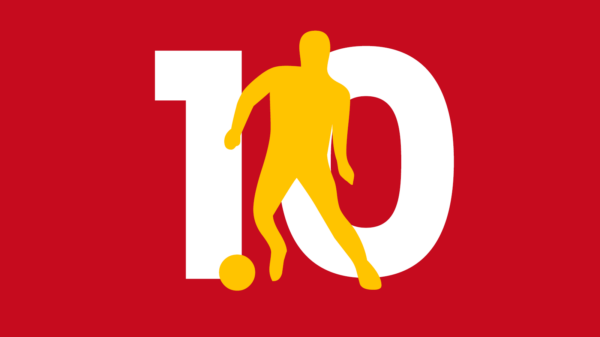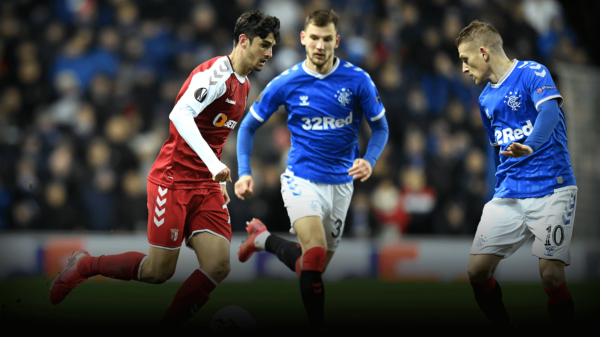El Clasico has become perhaps the most high profile fixture in club football. The historic rivalry between the clubs, the battle for supremacy between Ronaldo and Messi along with a star studded supporting cast, the possible implications in the title race all combine to form a heady mixture of apprehension and euphoria. The world waits with bated breath for kickoff only for it to be taken away by the plethora of talents on the pitch.
Barcelona 2-1 Real Madrid
Line ups
Barcelona: 13. Bravo // 22. Alves, 3. Pique, 24. Mathieu, 18. Alba // 4. Rakitic, 14. Mascherano, 8. Iniesta // 10. Messi, 9. Suarez, 11. Neymar
Real Madrid: 1. Casillas // 5. Carvajal, 3. Pepe, 4. Ramos, 12. Marcelo // 19. Modric, 8. Kroos, 23. Isco // 11. Bale, 9. Benzema, 7. Ronaldo
Barcelona in possession
Barcelona played a wide play-orientated 4-3-3 with the exterior central midfielders situated in the half spaces and Mascherano as a single pivot. Neymar and Messi positioned themselves outside their near-full back before cutting inside – Suarez occupied the opposition central defenders.
Real Madrid sat in a 4-4-2 with Bale as seen in the photo, varying their structure depending on his form of pressing/attacking. Ronaldo played as a disproportionate left-striker but made diagonal runs, anticipating crosses and being at the end of them.
Real Madrid in possession
Barcelona sporting a 4-4-2 once Neymar drops back to defend while Kroos drops near the centre backs to form a 3-4-3/4-3-3 depending on the movements upfield and movements from himself into the midfield stratum.
Barca’s central midfielders exploit half spaces and flanks very well
At the start of the game, Barca’s central midfielders positioned themselves extremely well across midfield. With next to no central figure, rarely leaving a player stationed in the centre of the pitch, Iniesta and Rakitic moved to the halfspaces or flanks while Neymar and Messi followed to create overloads in midfield and overcome the Los Blancos’ lopsided 4-4-2 which depended on the intelligence of Isco.
In the above graphic, Iniesta is the central figure while the other attackers move out to the flanks or the halfspaces to provide themselves as an outlet at specific angles.
Mascherano comes into the half space to provide another out-ball for Messi who has been dropping deep to have a wider viewpoint of the field and create. Neymar usually positions himself outside his near-side full back to give himself some breathing room before cutting inside. This usually would leave a player isolated but the support provided from the overlapping Alba, the drifting Suarez and the majestic Andres Iniesta (seen later in the build-up to the goal) were the key aspects in making Real’s defence vulnerable.
Even with Barcelona not at their best, they successfully used this to torment Madrid consistently throughout the match and without a target man/complete player such as Suarez up top to occupy defenders and hold the ball up, this strategy would not have worked. The reason for this is that Suarez has matured over the past two years and since the start of 2013-14 at Liverpool he became one of the most selfless, hard-working and most talented players in the world which makes him one of the best players in the world. Therefore Suarez was found almost everywhere, in the right place at the right time, to provide support to his teammates and drive, determination against the Real Madrid defenders.

Suarez’s heat map. Via squawka.com
Build-up to first goal a perfect example of Barcelona’s strategy
Barcelona scored their first goal after a Jeremy Mathieu header connected with a Lionel Messi free-kick to nod the ball into the bottom corner. The reason for this began with Barcelona winning the ball back and Andres Iniesta taking control from there. He began to move into various pockets of space, passing it back and forth with other players to move the Real Madrid midfield towards a certain end of the field. The circulation was superb, moving the ball seamlessly without having to encounter any problems – ironically, as Barca’s circulation in this game was lethargic at times and was certainly not at their best – and Alba, Neymar and Suarez formed a support group around the great Andres.
A third line pass from Iniesta resulted in taking out 3 Madridistas and Pepe conceding a foul after clipping Suarez from behind. Suarez, who was looking to hold up play, helped him to either link the play back with the other players moving into space or winning a free-kick for the team. He won the free-kick, and Barcelona were in a good position to score.
Messi’s free-kick helped the players exploit Real’s poor man-marking system, especially Ramos, who failed to adequately challenge Mathieu as he allowed him to get goal side of him – keeping him onside at the same time. Real’s exterior defenders, zonally marking the box, were rendered useless as they didn’t even form a wall. Modric and Bale (members of the ‘wall’) stood apart, ball-watching and offered no help to the defenders behind them. Sure, it may have not been their fault but their whole set-piece strategy here was a dangerous mistake that allowed Barcelona to further control proceedings – until Real exploited Barcelona’s defence through their swift counter-attacks.
Real counter-attack with fast, one-touch football and it reaps the rewards
A key feature of the Real strategy was their ability to attack Barcelona at high speed. This resulted in most of their chances, most notably when Marcelo began their attacks and Ronaldo spearheaded them. The first one came in the 8th minute when Ronaldo hit the bar after a Benzema cross and was oh so close to putting Real ahead at the Camp Nou.
Marcelo attempted 10 dribbles, two less than the game’s most prominent dribbler – Neymar – and was consistently supporting Real Madrid’s players, creating chances and penetrating Barcelona’s defence. It’s safe to say the Blaugrana defence looked dumbfounded at times with the high-speed football on offer from the Madridistas.
A key example of Marcelo’s importance to the game was in the 11th minute when after Real switched the play extremely slowly across the pitch, Marcelo received the ball and had only one intention – run into the space in front of him, gain ground on Barcelona’s players and slip a pass through to one of the attackers. This resembled his style of play where not only does he run to the byline but he cuts inside to shoot or pass. A great example is the goal in the Champions League Final against Atletico Madrid or in the game against Schalke (1st leg) this season.
Furthering Marcelo’s case as the game changer of Real Madrid, he is stationed on the left which means that he can link up with the one of the best players in football in Ronaldo while also being protected by the tenacious yet technical Isco. According to Whoscored, 42% of Madrid’s attacks came down their left as opposed to 27% and 31% in the middle and right flank – respectively.
It thus came as no surprise when Real equalised in great fashion after a counter attack led by Iker Casillas, rolling the ball past Barcelona’s attackers who were on the edge of Madrid’s box. Rakitic is known to be tenacious and hardworking too, so he tracks back to support the sometimes over-advancing runs of Dani Alves. In this counter attack he does exactly that but Dani Carvajal and Luka Modric heavily exploited the space left by Andreas Iniesta.
As Modric dribbled into the free right halfspace where Iniesta should have been, Benzema draws Pique out with a decoy diagonal run freeing up space for Ronaldo in the centre of the 18-yard box in the process, before backheeling the ball to the 2014 Ballon D’or winner to score the equaliser.
Real vertically open, Messi moves central to threaten
Here was one significant example of the lack of security between the lines for Real while sitting in a 4-4-2. Generally when teams defend in a 4-4-2 it is because it is one of the optimum formations in helping a team being compact defensively – if they use it correctly. By using it correctly, the team has to minimise space in between the lines, covering from the left halfspace to the right while ceding control on the flanks. Messi is at his best in between the lines while the all-rounder Suarez is dangerous in space, so Real should have really looked to minimise that area for the Barcelona attackers.
In the second half, Messi moved into the centre alongside Suarez and he dropped into his usual false 9 position near the halfway line where he was able to run at the opposition defenders and link up with his teammates around him.
Written by Hamoudi Fayad
- Hipster Guide 2016-17: Bayer Leverkusen’s tactics, key players and emerging talents - August 25, 2016
- Talent Radar: Saudi Pro League 10 Young Players (U-23) to Watch in 2016-17 - August 23, 2016
- Dry Grassroots: Youth Football Deficiencies in Western Asia - July 19, 2016



































































